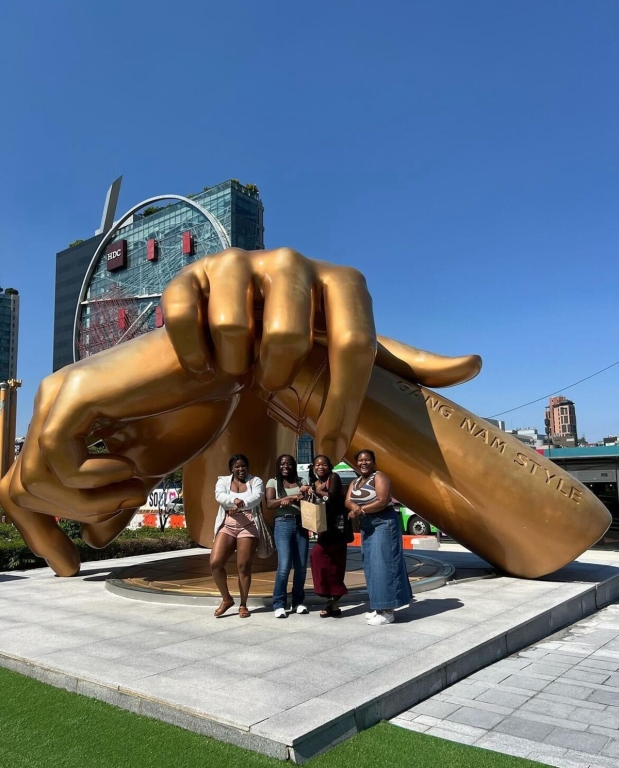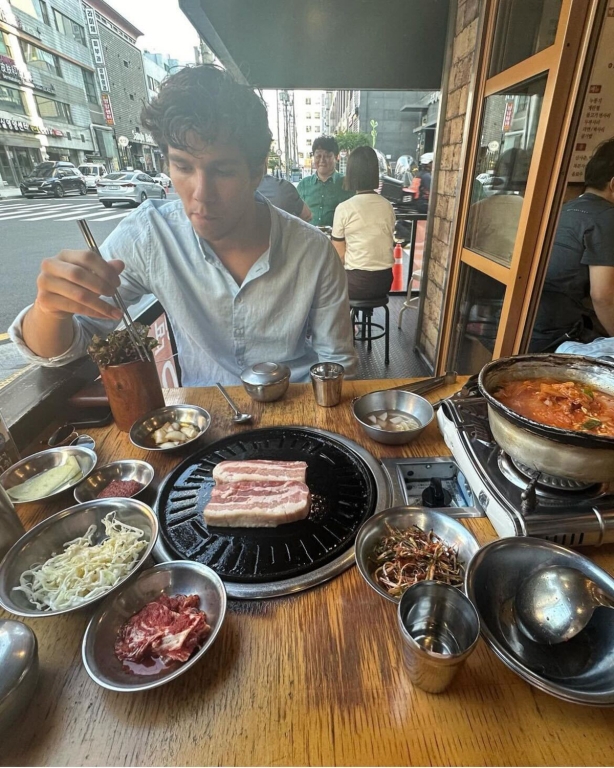
Spring Term’s Got Seoul Students in the Spring Term Abroad course Statistics in Korean Music explore mathematics in the traditional and contemporary music of Korea.
“The course has been really enjoyable because it creates a harmony between two worlds – music and mathematics – which most people believe are unrelated.”
~ Berkeley Wall ’24
What does Korean pop music have to teach us about mathematics? Students in Washington and Lee University’s Spring Term Statistics in Korean Music course are finding out while exploring the unique cultural landscape of South Korea.
As part of the immersive four-week semester, Assistant Professor of Mathematics Sybil Prince Nelson ’01 and Professor of Music Terry Vosbein are leading an abroad course based in Seoul, South Korea, that introduces students to Korean instruments and tuning systems and the relationship of math and music in the Western and Eastern worlds. The course specifically explores the applicability of Benford’s Law to musical composition. The Benford distribution is a mathematical pattern describing the frequency with which the first digit (1-9) appears in certain numerical datasets and how often each leading digit occurs at the beginning of numbers in a given dataset. This distribution is often observed in naturally occurring data sets, such as populations of cities, financial data and scientific measurements. The digit 1 tends to appear as the first digit more frequently than the others, followed by 2, then 3 and so on, with 9 being the least frequent. This distribution is widely used in forensic accounting, fraud detection and various other fields to spot anomalies or irregularities in datasets. The Benford distribution can emerge in music in the logarithmic scale of musical frequencies — just as certain numbers are more likely to appear as the first digit in datasets, their first digits tend to follow the Benford distribution when musical notes are converted to hertz.
Nelson has long been interested in how to fuse math and music, having majored in both during her time at W&L. She became interested in Benford’s Law after reading a paper on how it could be applied to the music of classical composers such as Ludwig van Beethoven and Johann Sebastian Bach. Determined to investigate the idea further, Nelson worked with her summer research students in the summer of 2021 and discovered that music became more and more Benford-distributed as time progressed from the medieval period to the romantic. She then partnered with the Advanced Immersion Mentoring (AIM) summer scholars program during the summer of 2022 to work with incoming first-year students to explore the distribution of note frequencies in artificial intelligence (AI) music as well as modern genres. During the course of that summer, Nelson asked her AIM researchers to pick their favorite genre of music to analyze. One student picked Korean pop – also known as “K-pop” – and the results were surprising.
“K-pop music was the most Benford-distributed of the three genres we looked at,” Nelson said. “The idea for the course is really twofold. I knew that classical Western music is Benford-distributed, but I didn’t know anything about traditional Eastern music and whether it would have the same properties. Also, we found that K-pop was strongly Benford-distributed, and I wanted to investigate that more as well.”
Vosbein was excited to work with Nelson when she approached him with the idea for the course. Vosbein, who was Nelson’s music adviser during her undergraduate career at W&L, said that while he will be providing students with a framework for musical composition and theory that will inform their coursework, he looks forward to learning along with them as the class explores traditional and contemporary Korean music.
“I went into the course quite sure that I will probably learn as much from the students as they will learn from me,” Vosbein said.
Students will use their music theory and math skills to create a Benford-distributed K-pop song as part of their final project. Berkeley Wall ’24, an anthropology major and poverty and human capability studies minor from Salem, Virginia, said the class offered an opportunity to blend disparate subjects in unexpected ways.
“The course has been really enjoyable because it creates a harmony between two worlds – music and mathematics – which most people believe are unrelated,” said Wall. “The underlying metrics of the world and the human desire to place patterns onto it has always fascinated me. Because of that, it is exciting to see how mathematics has been applied to music created by humans who were not attempting to fulfill the theories we are using. It creates a lot of big ideas and questions to see the natural world arrange into the mathematical world so neatly.”
Students have had the opportunity to study traditional Korean instruments, such as the gayageum, while receiving a crash course in Korean history and culture through site visits, readings and guest speakers. The class also included time practicing basic Korean language skills (dubbed “Survival Korean” in the course syllabus) with students from Yonsei University in Seoul. Brandon Bishop ’26, a computer science major from Bettendorf, Iowa, said the class appealed to him for the same reasons that W&L did – an interdisciplinary and multicultural approach to learning that helped him broaden his experiences of the world in college. Bishop said he has enjoyed the night markets and street food that the class has been able to partake in so far but has also deeply valued the expertise the class has exposed him to, including that of his instructors.
“Out of the four papers written on the Benford distribution in music, three of them were written by my professor,” Bishop said of Nelson. “I think this highlights how unique W&L’s professors are and how lucky I am to be able to learn from them.”
Nelson said she hopes to produce a paper grounded in the work she and her Spring Term Abroad class accomplish during their time in South Korea this month.
“This course has sparked so many ideas for future research,” Nelson said. “For example, we studied specific properties that separate Western pop music, Korean pop music and Japanese pop music. The difference lies in the chord progressions that are most widely used in each culture as well as the methods of layering those chords. In future iterations of this class, I would like to split the time between Korea and Japan and incorporate the music trends of both cultures.”
 Students in the Statistics in Korean Music Spring Term Abroad course explore Seoul, South Korea.
Students in the Statistics in Korean Music Spring Term Abroad course explore Seoul, South Korea. The class exploring the Gangnam district of Seoul, South Korea
The class exploring the Gangnam district of Seoul, South Korea Tiwaniya Tyler ’24 gets a photo opportunity with the hand prints of some of Korean pop’s biggest stars.
Tiwaniya Tyler ’24 gets a photo opportunity with the hand prints of some of Korean pop’s biggest stars. Students said new adventures in Korean cuisine were among their favorite experiences during the course.
Students said new adventures in Korean cuisine were among their favorite experiences during the course.
You must be logged in to post a comment.